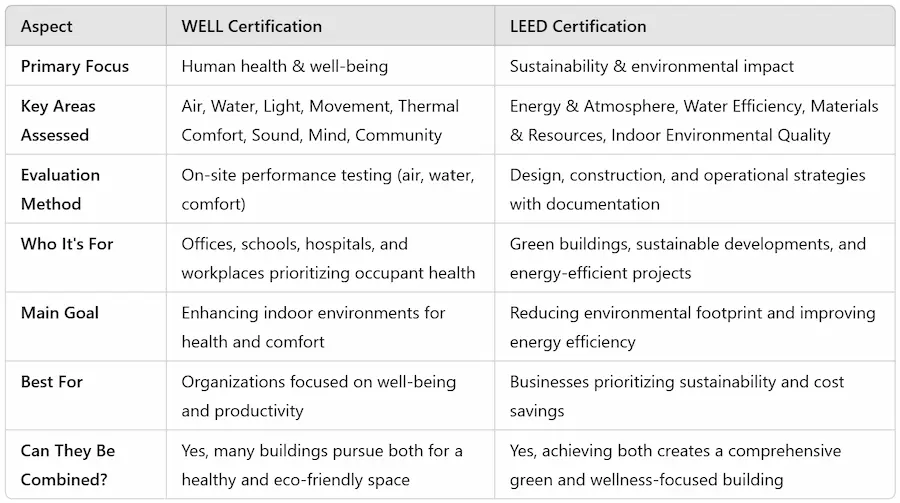What is WELL Certification?
The WELL Building Standard is a certification program developed by the International WELL Building Institute (IWBI) that focuses on enhancing the health and well-being of building occupants. Launched in 2014, it integrates scientific and medical research to establish performance-based measures across various aspects of building design and operation.
Key Concepts of WELL Certification:
- Air: Ensuring high indoor air quality through proper ventilation and pollutant reduction.
- Water: Providing access to clean and safe drinking water.
- Nourishment: Encouraging healthy eating habits by offering nutritious food options.
- Light: Optimizing lighting to support circadian rhythms and visual comfort.
- Movement: Promoting physical activity through building design and amenities.
- Thermal Comfort: Maintaining comfortable temperature and humidity levels.
- Sound: Implementing acoustic design strategies to reduce noise and enhance privacy.
- Materials: Using safe and sustainable building materials.
- Mind: Supporting mental health through design elements and policies.
- Community: Fostering a sense of community and social interaction within the building.
Key Benefits of WELL Certification
- Healthier Indoor Environments
WELL ensures clean air, safe drinking water, and low-toxin materials, reducing the risk of respiratory issues, allergies, and long-term health concerns. - Enhanced Employee Productivity & Engagement
Offices designed with WELL principles see fewer sick days, higher focus, and better overall workplace satisfaction, improving business performance. - Better Sleep & Mental Well-being
Thoughtful lighting, noise control, and biophilic design (natural elements indoors) help reduce stress, improve sleep, and support mental health. - Increased Building Value & Market Appeal
Properties with WELL Certification are more attractive to tenants, employees, and investors, making them a smart long-term investment. - Stronger Brand Reputation
Companies in WELL-certified spaces demonstrate a commitment to employee well-being and sustainability, strengthening their brand and attracting top talent.
By prioritizing human health and wellness, WELL Certification goes beyond traditional green building standards, ensuring that indoor spaces not only conserve resources but also enhance the lives of those who use them every day.
How does WELL Certification work?
The WELL Building Standard v2 is a comprehensive framework designed to enhance health and well-being within buildings, focusing on ten core concepts: Air, Water, Nourishment, Light, Movement, Thermal Comfort, Sound, Materials, Mind, and Community.
Certification Process:
- Preconditions and Optimizations: Each concept comprises mandatory preconditions and optional optimizations. Projects must meet all preconditions to be eligible for certification and can pursue optimizations to achieve higher certification levels.
- Scoring and Levels: Projects earn points by fulfilling optimizations, with certification levels as follows:
- Bronze: 40 points (available only for shell and core buildings)
- Silver: 50 points
- Gold: 60 points
- Platinum: 80 points
- Performance Verification: An authorized WELL Performance Testing Agent conducts on-site assessments to verify that the building meets the required standards.
- Continuous Monitoring: To maintain certification, projects must regularly monitor and report on specific health and well-being metrics, ensuring ongoing compliance and promoting continuous improvement.
By adhering to the WELL v2 framework, organizations can create environments that not only support occupant health but also enhance productivity and overall quality of life.
WELL Certification Process
To secure WELL, projects must first prepare and submit a project application. This application includes information about the property, its systems, and the intended use of the space. Once the application is reviewed and accepted, the project will be evaluated against the WELL standards. During this stage, project owners must expect on-site assessments, document reviews, and performance testing.
The entire WELL Certification process consists of the following steps:
Step 1: Pre-assessment
The building’s systems and features are evaluated to determine their readiness for WELL certification.
Step 2: On-site assessment
This is conducted to verify that the building meets the WELL standards. This process includes reviewing documentation, observations of building systems and features, and performance testing.
Step 3: Review and verification
A WELL Accredited Professional (WELL AP) evaluates and verifies the report after the on-site assessment.
Step 4: Certification
After the verification, the project will be certified as meeting the WELL standards.
Strategies for Achieving WELL Certification
To achieve WELL certification, building owners and designers can implement a variety of strategies:
- Air Quality: Improve ventilation systems, use high-quality air filters, and reduce indoor pollutants from materials and furnishings with the help of advanced air quality monitoring systems like uHoo.
- Water Quality: Install water filtration systems and provide easy access to drinking water.
- Light Quality and Quantity: Optimize daylighting, use energy-efficient lighting systems, and reduce glare.
- Nourishment: Offer healthy food options in on-site cafeterias and vending machines.
- Movement: Incorporate fitness facilities, walking paths, and ergonomic workstations.
- Mind: Design spaces that promote relaxation, creativity, and social interaction.
- Community: Create spaces for social gatherings and community events.
How to Achieve WELL Certification with uHoo Aura
If you’re aiming for WELL Building Standard® certification, maintaining a healthy indoor environment is key—and that’s where uHoo Aura comes in. WELL certification focuses on ten areas, including Air Quality and Thermal Comfort, both of which uHoo Aura helps optimize. Here’s how:
1. Keep Indoor Air Quality (IAQ) in Check
- Real-time Monitoring: uHoo Aura continuously tracks pollutants like VOCs, CO₂, particulate matter (PM), temperature, and humidity, all of which impact WELL certification.
- Better Ventilation & Cleaner Air: With accurate data, you can fine-tune your HVAC system, reduce indoor pollutants, and ensure optimal air circulation—helping you meet WELL’s air quality standards.
2. Ensure Thermal Comfort for Occupants
- Monitor Temperature & Humidity: Keeping spaces comfortable is essential for WELL certification. uHoo Aura helps maintain ideal indoor conditions, ensuring people feel good and perform at their best.
3. Simplify Performance Verification & Reporting
- Data-Driven Compliance: WELL certification requires proof that your space meets air quality and comfort standards. uHoo Aura’s automated reports make it easy to provide the necessary documentation.
By integrating uHoo Aura, you’re not just improving IAQ—you’re creating a healthier, more comfortable space while streamlining the WELL certification process.
WELL Certification vs. LEED Certification: What’s the Difference?
Both WELL and LEED certifications promote healthier, more sustainable buildings, but they focus on different aspects:




